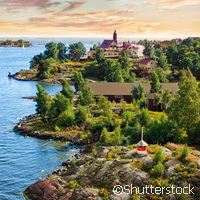Finland aspires to reduce greenhouse gas emissions by 80 % by 2050
The European Commission's 'Roadmap for moving to a competitive low-carbon economy in 2050' has prompted specialists in Finland to assess their country's chances of achieving the 80 % greenhouse gas emission reduction targets. In their report, 'Low Carbon Finland 2050 - VTT clean energy technology strategies for society', VTT Technical Research Centre of Finland gathered together their technology experts in clean energy production, smart energy infrastructures, transport, buildings, and industrial systems, as well as experts in energy system modelling and foresight. They then assessed the technological opportunities and challenges involved in reducing Finland's greenhouse gas emissions. Although the goal signals a tough one for Finland, the experts concluded that despite the strict EU low-carbon economy targets for 2050, it is within Finland's reach. As long as all sectors that produce or consume energy cooperate. The experts also believe that greenhouse gas emissions can be reduced by as much as 90 % if clean energy technologies are developed and adopted at an accelerated pace in energy production, industry, housing and transport. Collectively, they believe that VTT's leading-edge 'Low Carbon and Smart Energy' related research, enables new solutions with a demonstration that is the first of its kind in Finland, and the introduction of new energy technology onto national and global markets. Currently, Finland benefits from the availability of substantial reserves of renewable energy and a diversified energy structure. It is predicted by VTT that by 2050, 85 % to 100 % of Finnish electricity could be produced free of carbon dioxide. To do this requires diverse energy production and the widespread adoption of carbon capture and storage (CCS) technologies, in connection with both fossil fuel and biomass use. When analysing the country's buildings they found that the majority consumed 40 % of end-use energy. Due to Finland's northerly location (it is at 60 degrees to 70 degrees North latitude), heating energy consumption takes up a large proportion of energy use: 22 % of final energy use is employed in the heating of buildings. Due to their extreme climate, Finnish buildings are well insulated and all new buildings have heat recovery from ventilation. Of the final energy used by buildings, 85 % to 95 % could be carbon neutral in 2050. Some buildings could even produce energy locally. Encouraging people to use automated controls also enables energy savings when people are not present. Two-way networks for electricity and heating will enable local energy production and implementation of plus energy houses. The proportion of the industrial sector in final energy consumption is high in Finland. In 2009, its share was 42 %, whereas the average for the EU-27 was 24 %. Industry is the largest energy end-use sector in Finland, with paper, pulp, metal and chemical being the main industrial energy consumers. The energy use of the industrial sector is a major reason for the high energy intensity of the Finnish economy compared with other industrial countries. In 2010, the total primary energy supply/gross domestic product (GDP) ratio was nearly 30 % higher in Finland than in Organisation for Economic Co-operation and Development (OECD) countries, on average. However, if the industry significantly improves its energy efficiency and adopts CCS, then 80 % of the energy consumed by industry will be carbon neutral. Resource efficiency will then be improved and the use of recycled materials increased. In terms of domestic transport, this accounts globally to around 15 % of total greenhouse gas emissions, and in Finland its contribution is currently almost 20 %. However, reducing the level of carbon-neutral energy is achievable by 70 % to 80 %, simply by opting for the fastest energy savings: this can be achieved by using intelligent control strategies and improving the envelope, ventilation and heating systems and sources. Already there is great demand for biofuels; these could constitute up to 40 % of the total energy consumed by the transport sector. By 2050, it is possible to reduce the energy demand of transport to less than half of today's level. While passenger cars can run on electricity captured in a battery or released from hydrogen in a fuel cell, only low-carbon or carbon-neutral biofuels can offer sufficient energy density for diesel engines in heavy long-range road haulage. In terms of energy production and infrastructure, the use of variable power generation, especially wind and solar power, will play a central role in Europe. New transmission interconnections are needed to transmit variable generation to load centres. Finland could offer new plant solutions for peak and intermediate loads using biomass-based fuels.For more information, please visit: 'Low Carbon Finland 2050 - VTT clean energy technology strategies for society':http://www.vtt.fi/inf/pdf/visions/2012/V2.pdf
Countries
Finland



